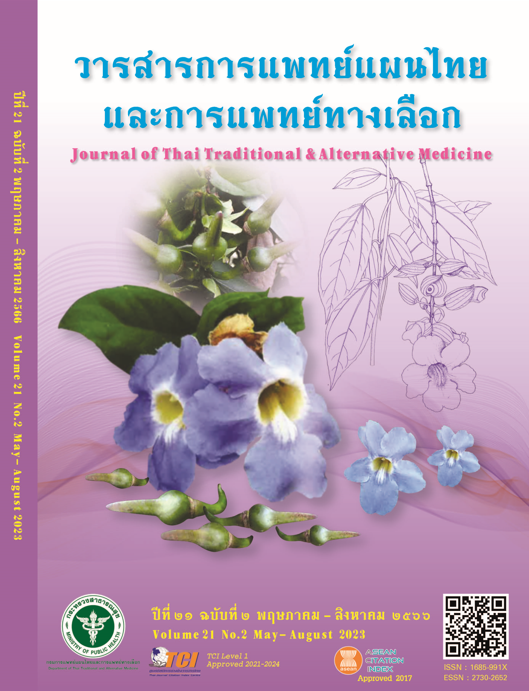Development and Method Validation of Mitragynine Contents in Mitragyna Speciosa (Korth.) Havil. Leaves by Ultra High Performance Liquid Chromatography
Main Article Content
Abstract
Background and objective: Kratom (Mitragyna speciosa) plant has been removed from the list of controlled substances in Category 5, making it legally permissible for possession and consumption. Additionally, kratom is now recognized for its economic value. The primary active ingredient in kratom leaves is mitragynine, which induces pleasurable effects and provides pain relief. The objectives of this study were to develop a method for analyzing the quantity of mitragynine in kratom leaves using ultra-high performance liquid chromatography (UHPLC) and to test the validity of the developed analysis method.
Methods: The study was divided into three steps: developing the UHPLC method for analyzing mitragynine in kratom leaves, testing the validity of the analysis method, and analyzing the quantity of mitragynine in 17 kratom leaf samples.
Results: The appropriate conditions for the analysis were using an ARC-18 stationary phase measuring 4.6 x 150 millimeters with a particle size of 2.7 micrometers and a mobile phase consisting of 0.1% ortho-phosphoric acid in water and 0.1% ortho-phosphoric acid in acetonitrile at a flow rate of 1.0 milliliter per minute. The detection wavelength was set at 222 nanometers, with an average retention time of 7.19 minutes. The applicability test of the analysis method showed that the calibration curve was linear in the concentration range of 0.30–30.00 micrograms/milliliter, with a correlation coefficient (r) of 0.9998. The mean recovery percentage ranged from 99.72% to 100.88%, and the HORRAT values were in the range of 0.21–0.51. The precision test showed a relative standard deviation of 0.53 for samples analyzed on the same day and 0.78 for samples analyzed over three consecutive days. The limit of detection (LOD) was found to be 0.19 micrograms/milliliter, and the limit of quantification (LOQ) was 0.64 micrograms/milliliter. Using this developed UHPLC method for analysis, the study determined the quantity of mitragynine in the 17 kratom leaf samples, with concentrations ranging from 0.99% to 1.89% w/w.
Discussion: The method developed for analyzing mitragynine in raw kratom leaves using UHPLC involves the extraction of dried kratom leaves with ethanol as the solvent through the reflux method. The results of the validity test of the analysis method were all within acceptable limits. This developed analysis method requires less time for analysis and involves a simple, convenient, and rapid preparation of the mobile phase.
Conclusion and recommendation: The developed UHPLC method for analyzing mitragynine in kratom leaves was found to be accurate, precise, and suitable for determining the quantity of mitragynine in raw kratom leaves and kratom leaf extracts. It can be used for routine analysis.
Article Details

This work is licensed under a Creative Commons Attribution-NonCommercial-NoDerivatives 4.0 International License.
References
Bunsupa S. Kratom, the plant that everyone wants to know. [Internet]. [cited 2020 Dec 24]; Available from: https://pharmacy.mahidol.ac.th/th/knowledge/article/354/กระท่อม/ (in Thai)
Department of Thai Traditional and Alternative Medicine. Guidelines for the utilization of Kratom. 1st ed. Bangkok: Beyond Publishing Co., Ltd.; 2022. (in Thai)
Thongpraditchote S. Pharmacological effects of mitragynine, an active compound in kratom leaves. Herbal Information Booklet. 2006;24:6-16. (in Thai)
Hooper D. The anti-opium leaf. Pharma J 1907;78:453.
Field E. XCVIII.-Mitragynine and mitraversine, two new alkaloids from species of Mitragyne. J. Chem. Soc., Trans. 1921;119:887-91.
Lee CM, Trager WF, Beckett AH. Corynantheidine-type alkaloids- ii: absolute configuration of mitragynine, speciociliatine, mitraciliatine and speciogynine. Tetrahedron. 1967;23:375-85.
Ponglux D, Wongseripipatana S, Takayama H, Kikuchi M, Kurihara M, Kitajima M, Aimi N, Sakai S. A new Indole Alkaloid, 7 alpha-Hydroxy-7H-mitragynine, from Mitragyna speciosa in Thailand. Planta Med. 1994;60(6):580-1.
Idayu NF, Hidayat MT, Moklas MA, Sharida F, Raudzah AR, Shamima AR, Apryani E. Antidepressant-like effect of mitragynine isolated from Mitragyna speciosa Korth in mice model of depression. Phytomedicine. 2011;18(5):402-7.
Keawpradub N. Kratom leaves, medicinal properties, benefits and harms. [Internet] [cited 2020 Dec 24]; Available from: https://www.oncb.go.th/ncsmi/cottage8/ใบกระท่อม%20สรรพคุณทางยา%20ประโยชน์และโทษ.pdf (in Thai)
Phimphasri R. Thairath Plus: Money. Kratom, a new economic plant of Thailand how well will it go maybe depends on Indonesia. [Internet] [cited 2020 Dec 24]; Available from: https://plus.thairath.co.th/topic/money/100383 (in Thai)
Kratom Plant Act B.E. 2565 (2022). Published in Royal Gazette, Vol. 139, Part 52 Kor. (2022 Aug 26) (in Thai)
Herbal Products Act B.E. 2562 (2019). Published in Royal Gazette, Vol 136, Part 56 Kor. (2019 Apr 30) (in Thai)
Kikura-Hanajiri R, Kawamura M, Maruyama T, Kitajima M, Takayama H, Goda Y. Simultaneous analysis of mitragynine, 7- hydroxymitragynine, and other alkaloids in the psychotropic plant “kratom” (Mitragyna speciosa) by LC-ESI-MS. Forensic Toxicology. 2009;27(2):67–74.
Wang M, Carrell EJ, Ali Z, Avula B, Avonto C, Parcher JF, Khan IA. Comparison of three chromatographic techniques for the detection of mitragynine and other indole and oxindole alkaloids in Mitragyna speciosa (kratom) plants. J Sep Sci. 2014;37(12):1411-8.
Mudge EM, Brown PN. Determination of mitragynine in Mitragyna speciosa raw materials and finished products by liquid chromatography with UV detection: Single-laboratory validation. J AOAC Int. 2017;100(1):18-24
Parthasarathy S, Ramanathan S, Murugaiyah V, Hamdan MR, Said MIM, Lai ChS, Mansor SM. A simple HPLC-DAD method for the detection of psychotropic mitragynine in Mitragyna speciosa (ketum) and its products for the application in forensic investigation. Forensic Sci. Int. 2013;266(1-3):183-7.
Department of Medical Science. Practical guidlines for testing the accurary of chemical analysis methods in the single laboratory setting. Nothaburi: Department of Mecial Science, 2006.


